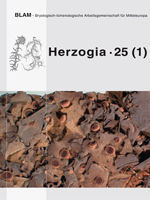Köckinger, H., Kučera, J., Hofmann, H., Müller, N. & Amann, G. 2012. Barbula consanguinea discovered in Switzerland and Austria, with a revision of former European records of B. indica. — Herzogia 25: 61–70.
Barbula consanguinea is newly reported from Europe based on recent records from Switzerland and Austria. B. consanguinea is well characterized among the European species of the genus by (1) clusters of small, brown and mostly clavate axillary gemmae, (2) lanceolate leaf shape, (3) not distinctly sheathing leaf base, (4) partially recurved leaf margin and (5) doubly prorate superficial cells on dorsal side of costa. Due to the similarity to Barbula indica, earlier European records of this species from Hungary, Croatia and Italy were revised. They need to be attributed to B. consanguinea, as well as the type of the recently described East Asian B. indica var. kurilensis. In Europe the species mainly occurs in early pioneer sites on moist, base-rich, more or less calcareous silt, sand and gravel in alluvia of lowland courses of streams, in particular the Rhine, Reuss, Danube, Mura and Tagliamento. The phytogeographical status of the plant in Europe — native vs. recently introduced — is discussed.





